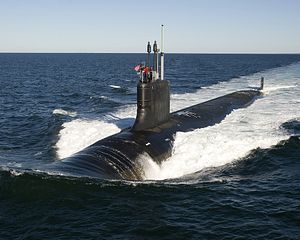The U.S. Navy, the world’s most powerful naval force, plans to add nine new warships including the long-delayed nuclear-powered Gerald R. Ford-class aircraft carrier USS Gerald R. Ford in 2017. Other ships include the Independence-class Littoral Combat Ship (LCS) USS Gabrielle Giffords and USS Omaha; the Freedom-class LCS USS Sioux City and USS Little Rock; the Arleigh Burke-class destroyers USS Rafael Peralta and USS John Finn; and the Virginia-class nuclear attack submarines USS Washington and USS Colorado.
The carrier USS Gerald R. Ford was supposed to be commissioned in 2016. However, the U.S. Navy’s most expensive warship faced a number of technical problems with many of its new and unproven systems including the two main turbine generators and the so-called the Advanced Arresting Gear (AAG) on the flight deck (See: “Is the US Navy’s New Supercarrier Facing Additional Delays?”). So far, no official 2017 commissioning date has been announced for the carrier. Overall, the U.S. Navy intends to commission a fleet of ten Ford-class carriers.
The USS Gabrielle Giffords was handed over to the U.S. Navy in December 2016 and will be commissioned in the first half of 2017 along with the USS Omaha. “The Independence-class variant of the LCS features a unique trimaran hull and a larger flight deck than the Freedom-class. In addition, it has more fuel capacity and a wider operational range,” I explained elsewhere. The other two Freedom-class LCSs will also be commissioned in the first half of 2017.
As I reported previously, in December 2015, U.S. Defense Secretary Ashton Carter ordered the U.S. Navy to reduce the number of LCS to be built from 52 to 40 (See: “US Navy’s Fleet of Littoral Combat Ships Will Be Cut to 40 Vessels”).
The Arleigh Burke-class destroyers USS Rafael Peralta completed acceptance trials in December and November 2016 respectively. They are the 65th and 63rd Arleigh Burke-class destroyers fitted with the Aegis Combat System to enter service with the U.S. Navy. An exact commissioning date in 2017 has also not been set yet for either of the two ships. The U.S. Navy intends to eventually field 76 guided-missile destroyers of the class.
The Virginia-class nuclear attack submarines USS Washington and USS Colorado are expected to be commissioned in the fall and summer of 2017 respectively. The boats are the fourth and fifth out of a total of eight Block III subs built with the new Virginia Payload Modules (VPM) – larger tubes that increase the ship’s missile-firing payload possibilities (See: “US Subs Getting Fire Power Boost”). They also feature a redesigned bow, in comparison to Block I and II submarines of the class. In total, the U.S. Navy plans to induct 48 Virginia-class boats.
As I noted in 2015, with “older Los-Angeles-class fast-attack submarines (built between 1972 and 1996) retiring at a faster pace than Virginia subs are added, the U.S. Navy will face a shortfall in the number of active boats in the near future.” Three Los-Angeles-class subs are slated for decommissioning in 2017.
As I reported elsewhere, President-elect Donald Trump has committed himself to expand the U.S. Navy from currently 272 to 350 ships (See: “Trump’s New Navy: Does the US Really Need 350 Warships?”). (The Diplomat’s Steven Stashwick has analyzed the likelihood of this to occur here and here.)

































